
Latest News
- Hyundai E&C Becomes Key Player in the Nuclear Decommissioning Market
- Hyundai E&C Accelerates Global Nuclear Expansion into the U.S. Nuclear Market
- Hyundai E&C Shifts into High Gear to Enter Nordic Large-Scale Nuclear Market
- Hyundai E&C Strengthens Korea-Japan Cooperation in Energy Transition and New Growth Businesses
- Hyundai E&C Signals Green Light for Large-Scale Nuclear Power Plant Business in Europe
[Smart Construction Encyclopedia VoI.05] ICT: Advanced Connectivity Technology Bringing the World Together
Communicate, connect, and change the world through information
A world where cars drive on their own, and robots do the heavy lifting! What seems like something out of a movie is becoming a reality. All thanks to ICT (Information and Communication Technologies). Indeed, ICTs, advanced information and communication technologies, are rapidly changing our world, making it more convenient and faster.

What is Information and communication technologies (ICT)?
ICT is an acronym for Information Technology (IT) and Communication. In other words, while traditional IT deals with information, ICT emphasizes communication with IT technologies such as smartphones, mobile devices, and remote control.
In this context, communication is not about human-to-human conversations, but about people-to-things or things-to-things connecting via the Internet and mobile to provide better services to people. For example, in the case of smart healthcare, ICT is used to collect and analyze patient health data and wearable devices allow them to monitor their health status in real time and receive remote care anytime, anywhere. In addition, ICT is being used for many applications such as transportation, finance, and energy. Especially, in the construction sector, which is considered the most traditional sector, ICT is being used as a technology central to smart construction and smart cities.

ICT, IoT, AI? Different tech terms are a bit confusing
In addition to ICT, there are other terms related to the Fourth Industrial Revolution, such as IoT (Internet of Things), AI (artificial intelligence), cloud, and big data. First of all, IoT stands for Internet of Things, which refers to intelligent services in which objects are connected to the Internet and information is collected and communicated in real time with embedded sensors without human intervention. For example, when you use public transportation, you can tap your smartphone on the terminal and it will automatically recognize and pay the fare. While ICT is a larger umbrella term that encompasses all digital technologies, IoT refers to the technology that allows objects connected to the Internet to interact and exchange data.
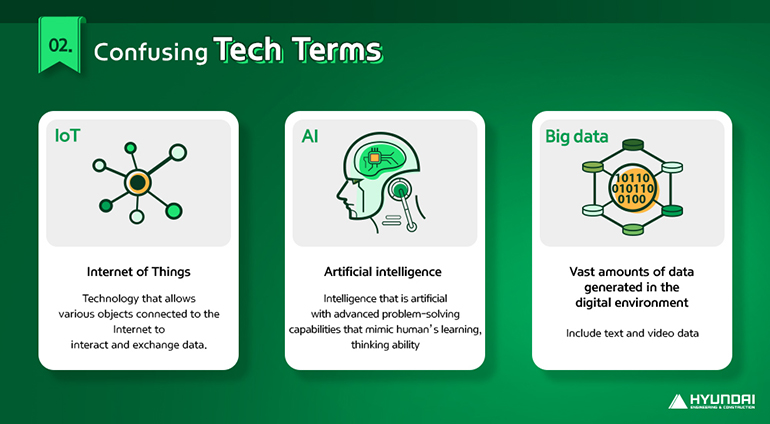
Artificial intelligence (AI) refers to intelligence that is artificial, that mimics human learning, thinking, and other abilities, and has advanced problem-solving capabilities. AI was popularized by the Go match between Lee Sedol and AlphaGo. Chatbots that communicate with consumers or features that automatically recommend TV programs based on a user's viewing habits all utilize AI technology. Big data refers to the vast amount of data generated in the digital environment. Compared to data generated in the analog environment, big data is characterized by a larger volume, with shorter generation cycle, and also includes text and image data, mainly used for business applications such as targeted advertisement.
ICT expands the realm of industries
ICT is already being applied to many industries around us. In particular, as IoT is rapidly evolving, barriers between industries are breaking down and converging, introducing new products and services. Among them, the automotive industry is showing the fastest evolution by developing smart cars that apply ICT technology. In particular, self-driving cars, which are equipped with technologies for recognizing the surrounding environment and autonomous driving, are often referred to as culmination of advanced technologies.
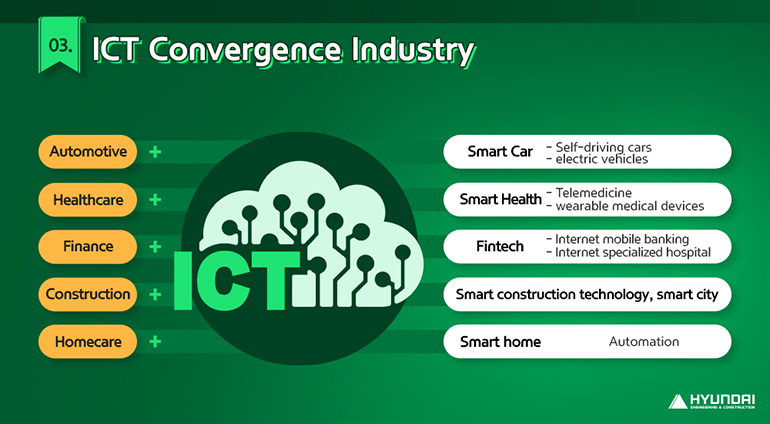
In the healthcare sector, smart healthcare, which helps to manage people's health conditions and provide customized healthcare services without time and place restrictions, is gaining traction. It allows remote healthcare connecting hospitals and patients, and provides healthcare services after analyzing the data of individuals. In addition, the financial sector is developing various fintech services, starting with Internet and mobile banking, and launching Internet specialized banks.
Convenience in everyday life! Smart home with ICT
The image of our homes, where we spend most of our time, is also changing along with ICT technology. Various features of our home are evolving, from remote systems that control lighting, temperature, and home appliances to voice recognition services, and Hyundai E&C is the first construction company to introduce a smart home system called Hi-oT, an acronym for Hyundai and IoT, ushering in the era of “smart apartments”.
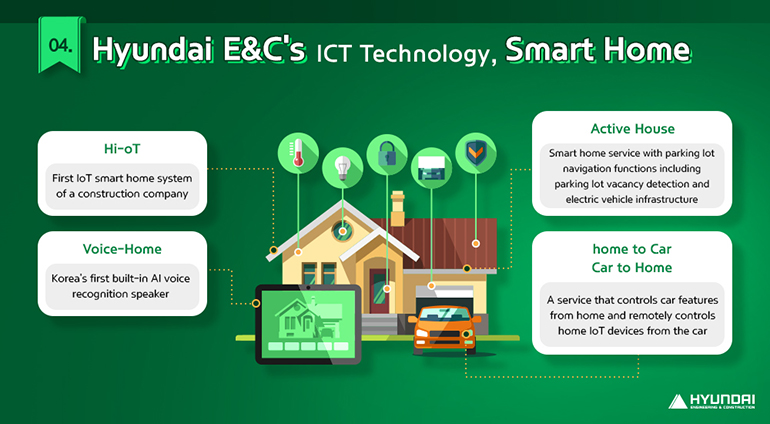
Hi-oT 1.0, developed by Hyundai E&C for the first time in the construction sector in 2016, was first applied to Hillstate Dongtan. The IoT-based home appliances and communications systems were wirelessly connected to operate on their own. For example, a robot vacuum cleaner or air purifier operated automatically when the homeowner activated the return mode when returning home. In 2018, in collaboration with Hyundai AutoEver, the company developed Hi-oT 2.0, which controls everything from cooling and heating systems to home appliances with a single wallpad, thus setting the standard for smart homes.
Hyundai E&C's smart home was upgraded once more in 2020. The company's first voice-activated speaker, Voice-Home, is an innovative service that allows homeowners to control their home environment with their voice using a built-in Voice-Home device. The lights are turned off before going to bed, and the air conditioner and gas valves are automatically shut off before going out. You can even be reminded of the weather or important events, all with a simple voice command. In addition, the Home to Car service allows you to control your car with your voice when you leave the house, leaving the ignition on or presetting the temperature inside the car.
Last year, Hyundai E&C introduced Active House, an extension of its smart home service to the mobility sector. It includes a parking lot navigation feature that connects the infrastructure on the complex to the car, and provides information to the driver about vacant parking spots, electric vehicle charger availability, and which building gate to use through a real-time underground parking lot monitoring system. The service, which was launched at The Banpo La Class and The H Xi Gaepo will be expanded to more The H and Hillstate properties in the future.
ICT enhancing on-site safety and quality
ICT technology can be found not only in apartments but also in construction sites. This is because smart construction technologies are being actively developed and applied to increase the efficiency and quality of construction. In the design and planning stages, augmented reality (AR)/virtual reality (VR) technology have been introduced to BIM* to make 3D drawings more visual, or drones have been used to collect site survey data and integrate them into the design. In particular, ICT technology is important in the construction sector because it ensures on-site safety. By using IoT, construction sites can share their status in real time and respond to hazardous situations immediately, leading to a safer environment.
*BIM(Building Information Modeling): A construction information modeling technology that integrates information from the entire construction process and utilizes it in the production, management, and operation phases.
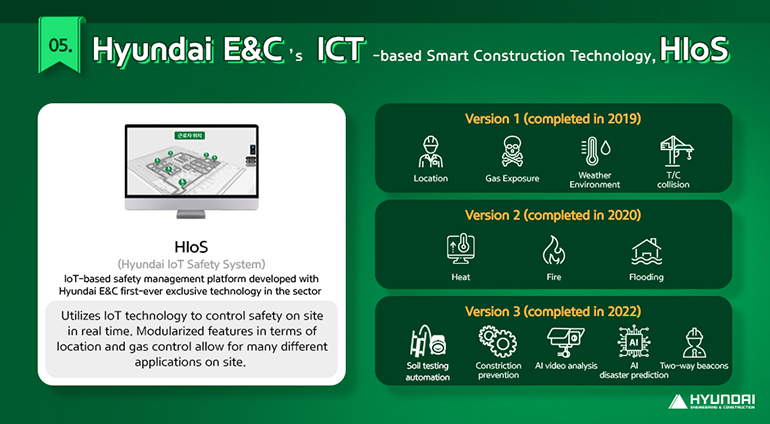
Hyundai E&C is also making strides in the field of smart construction technology. Hyundai E&C piloted the Hyundai IoT Safety System (HIoS), an IoT sensor-based safety management platform developed with the industry's first proprietary technology, at the Tehran Road 237 projet site under development. The HIoS collects information through on-site sensors and when it detects an abnormality, it raises an alarm to warn of a dangerous situation. At the same time, it shares the status information with pre-configured site safety managers and headquarters managers. This allows for a rapid respond to risks quickly and prevent accidents in advance. Hyundai E&C's HIoS, which was initially launched with four functions, including ▶ worker location control ▶ confined space gas leak detection ▶ tower crane collision prevention ▶ and weather and environmental management, has added sophistication and detail to site management by introducing additional features.

In addition to safety management, ICT technology plays a major role in improving construction quality. Hyundai E&C has developed a BIM-based AR quality management platform that can predict post-construction quality by augmenting 3D models on top of actual buildings and has piloted it at the Hillstate Hoam (Chungju) site. In addition, Hyundai E&C also introduced “Q-Pocket”, a smart integrated inspection system that allows real-time quality control via mobile and web, enabling real-time response from inspection planning to defect management. It is a simple system that allows users to ▶identify and locate subcontractors by process, ▶check status, ▶automatically notify inspections, ▶and manage defects anytime and anywhere with only a mobile phone, and is said to be effective in improving the work efficiency and quality of on-site workers. In addition, remote drones that can be utilized for unmanned site management, unmanned ground vehicles (UGVs), and disaster prediction systems using AI are also major ICT technologies that Hyundai E&C is applying to its sites.
ICT, an integral part of smart cities
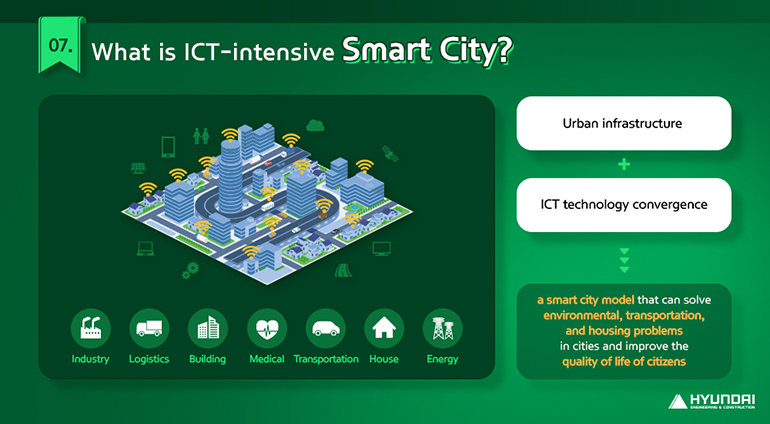
ICT technology is now moving beyond construction sites to cities. This is because ICT technology has made it possible for smart cities, which are referred to as future cities. Smart City refers to a smart urban model in which urban infrastructure and ICT technology are converged to solve environmental, transportation, and housing problems in cities and improve the quality of life of citizens. The United Kingdom, which is known for its global smart city, has been promoting “Smart London Together” since 2013 to provide digital services using city data and 5G. Some of the services include the London Data Store, allowing anyone to access and share information on the city's infrastructure, and a healthcare digital platform that allows users to take real-time sports lectures through artificial intelligence. Spain is also paying special attention to this field, establishing RECi, an organization dedicated to smart city development, and registering 65 cities as smart cities. One of the most prominent examples is Sentilo, a service that uses IoT technology to share real-time traffic, parking spaces, and weather information by attaching 18,000 sensors to roads and buildings.
Korea has also designated Sejong and Busan as pilot smart cities in 2018, and is accelerating to implement seven major services based on artificial intelligence and blockchain technology, including mobility (self-driving), energy/environment (renewable energy supply), and healthcare (personalized healthcare services).

Among others, the Busan Eco Delta Smart City, in which Hyundai E&C is participating, is the largest in Korea. The project consists of building a 3.8-kilometer waterway to connect the city and introducing innovative technologies that improve the quality of life including robots, healthcare, and smart mobility based on advanced ICT technology. Hyundai E&C was tasked with creating residential, commercial, and cultural facilities based on the concept of a hyper-connected city that fuses energy independence and advanced technology, and plans to implement a city model that creates a culture of energy production and consumption by introducing solar-based zero-energy building technology.
Hyundai E&C's advanced city-building technologies and know-how are also gaining prominence abroad. In June 2022, the company was awarded a section of Neom City project of Saudi Arabia, the world's largest smart city project, and in August of the same year, it signed an agreement to develop a smart city in a new city in Vietnam's Ha Nam province. In addition, Hyundai E&C plans to work on a mega project to build high-tech industrial zone comprising R&D centers, offices, commercial facilities, and smart logistics centers, as well as residential and service infrastructure facilities in the a city center. In particular the company will join the project from the basic design phase to lead the construction of a people-centric urban community of the future.
Since the pandemic, ICT technologies have improved by leaps and bounds. This is because our daily lives have become more convenient and safer due to the ability to control things remotely without the need for direct human contact. From residential spaces to roads and buildings to smart cities, one of the most advanced cities of the future, it is difficult to find a place in tact of ICT technology. That is why Hyundai E&C is keen to develop technologies that integrate ICT. Hyundai E&C is striving for a safer, more efficient and systematic construction environment and the products thereof! We cannot but help feel excited for the future of smart Hyundai E&C.

